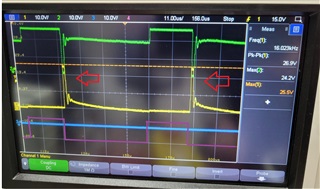Hi,
I have a DRV8720 conntected to 4x CSD18510 FETS. My motor is a brushed DC motor powered from 24V.
The driver is operating in Mode=High-Z where I am supplying the PWM directly.
In the picture below I have:
1. Green = Motor Phase A (measured at motor)
2. Yellow = Motor Phase B (measured at motor)
3. Blue = IN2 (measured close to the DRV8702)
4. Purple = IN1 (hand annotated, but also measured close to the DRV8702)

We note that during switching off of IN2 (falling edge of PWM) we get what looks like a phase reversal from the FETS.
Can anyone help explain why this is happening?
Thanks.



